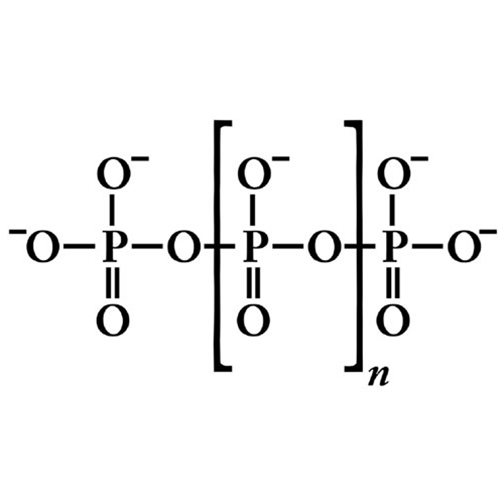The Many Faces of Polyphosphate
Marcos Salazar
May 2, 2014

Polyphosphate, also referred to as polyP, is a chain of high-energy phospho-anhydride-bonded inorganic phosphate created in vivo through ATP synthesis. Research on this compound has primarily focused on prokaryotic organisms. This research has revealed polyphosphate as a multifunctional compound, as it is used as an energy source to replace ATP, contributes to cell membrane formation and function, influences the structure of channels and pumps, and controls gene transcription in response to stress or stationary growth. In addition, polyphosphate influences pathogenicity, as robust polyphosphate levels promote a healthy virulent appetite in bacteria such as Salmonella, Shigella, V. cholerae, N. meningitides, P. aeruginosa, and M. tuberculosis, as well as in Trypanosoma, Toxoplasma, and Leishmania parasites. Microbial organisms with suppressed polyphosphate levels show defectives in motility, biofilm formation, and most importantly, virulence. Microbiologists have yet to discover the underlining mechanisms that explain why polyphosphate is involved in pathogenicity; therefore, much research is still being conducted to determine what pathways or virulent factors are affected by polyphosphate activity.
Polyphosphate is just as important in higher organisms. It localizes to various compartments within eukaryotic cells, including the nucleus, mitochondria, lysosomes, and cytosol. Polyphosphate has most notably been found to affect the circulatory system. Dr. James H. Morrissey, from the University of Illinois, discovered that polyphosphate activates the contact pathway, triggering a coagulation cascade. Upon injury to the endothelium, polyphosphate is released from activated platelets, which subsequently activate thrombin factors that influence blood clotting and proteins that induce inflammation. Therefore, polyphosphate inhibition is a promising therapeutic approach to combat blood clotting due to thrombosis and embolism. Dr. Morrissey, who has kindly made his polyphosphate reagent available to any researcher through our website, continues his research on polyphosphate. He and his colleagues recently found that it suppresses innate immunity through repression of the complement pathway.
Polyphosphate has many other activities in eukaryotic systems. It is involved in apoptosis, mTOR activation, and neuronal signaling. In terms of neuronal signaling, polyphosphate functions as a neurotransmitter, specifically facilitating astrocyte communication and affecting breathing and arterial blood pressure. In addition to these roles, a research group at the University of Michigan published an article this past March identifying polyphosphate as a previously unrecognized chaperone. This groundbreaking discovery found that polyphosphate mimics a chaperone protein by binding directly to unfolded proteins with high affinity and all in independent of ATP. Polyphosphate lives up to the chaperone standards by increasing protein stability in vitro and in vivo, preventing protein aggregation, and protecting proteins against stress-induced conformational changes.
A completely different use for polyphosphate was reported recently in an article profiling the work of a bioengineering research group at Virginia Tech. These scientists actually discovered a technique to abundantly produce hydrogen by combining a secret concoction of enzymes, xylose (a common wood and plant sugar), and polyphosphate. The process extracts “green energy” from plants in the form of hydrogen, which can be applied as a renewable energy resource that’s environmentally friendly. Polyphosphate is a compound with a growing list of varying activities and applications. To jump into your own research with this sought-out compound provided by Dr. Morrissey, visit the link below.
Tags:
polyphosphate, polyP, inorganic phosphate, blood clotting, contact pathway, blood coagulation, inflammation, virulence, pathogenicity, neurotransmitter, astrocyte signaling, mTOR activation, apoptosis
References:
- Smith SA, Mutch NJ, Baskar D, Rohloff P, Docampo R, Morrissey JH. Polyphosphate modulates blood coagulation and fibrinolysis. Proc Natl Acad Sci U S A. 2006 Jan 24;103(4):903-8.
- Morrissey JH, Choi SH, and Smith S.A. Polyphosphate: an ancient molecule that links platelets, coagulation and inflammation. Blood 119:5972-5979, 2012.
- Silvia N. J. Moreno, and Roberto Docampo. Polyphosphate and its Diverse Functions in Host Cells and Pathogens. PLoS Pathog. May 2013; 9(5): e1003230.
- Holmström KM, Marina N, Baev AY, Wood NW, Gourine AV, Abramov AY. Signalling properties of inorganic polyphosphate in the mammalian brain. Nat Commun. 2013;4:1362.
- Wat JM, Foley JH, Krisinger MJ, Ocariza LM, Lei V, Wasney GA, Lameignere E, Strynadka NC, Smith SA, Morrissey JH, Conway EM. Polyphosphate suppresses complement via the terminal pathway. Blood. 2014 Jan 30;123(5):768-76.
- Gray MJ, Wholey WY, Wagner NO, Cremers CM, Mueller-Schickert A, Hock NT, Krieger AG, Smith EM, Bender RA, Bardwell JC, Jakob U. Polyphosphate is a primordial chaperone. Mol Cell. 2014 Mar 6;53(5):689-99.


